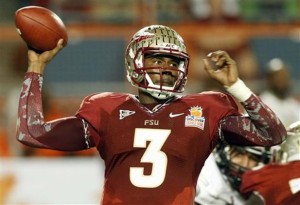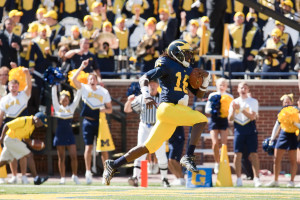Over the last three days, I analyzed the trades from the first round, rounds 2 and 3, and the final four rounds. Today, I wanted to discuss the things that stood out to me during the draft. In the comments, let me know what got your attention.
What was that blur? Chances are it came from BuffaloBuffalo wasn’t necessarily a slow team, with C.J. Spiller, Steve Johnson, and T.J. Graham, the track star from North Carolina State drafted in the third round last season. But in the 2013 draft, the Bills clearly placed an emphasis on improving the team speed. In the first round, GM Buddy Nix traded down and then selected Florida State quarterback E.J. Manuel, perhaps the quarterback with the highest ceiling in the draft. The 6’5, 237 pound quarterback ran a 4.65 40-yard dash at the combine and it seems likely that the Bills plan on running some read option plays this year. Buffalo also addressed the receiving group in a big way. First, Nix drafted USC wideout Robert Woods in the second round; then, he used the third rounder received from the Rams in the Tavon Austin trade to draft Texas wide receiver and Olympic athlete Marquise Goodwin (who ran a 4.25 40 in February). After the draft, Buffalo signed former Tennessee (and then Tennessee Tech) wide receiver Da’Rick Rogers, another high upside receiver (who went undrafted due to non-football reasons). The Bills also drafted Arkansas tight end Chris Gragg, who ran a 4.50 40, had a 37.5 inch vertical leap, and a 125 inch broad jump; all three marks were easily the best among tight ends at the combine. With Spiller, Goodwin, Gragg, and Manuel, Buffalo will have one of the fastest players in the NFL at each skill position.
Cleveland Browns Adopt the Belichick Model
Cleveland selected Barkevious Mingo with the sixth pick and Leon McFadden in the third round. Those were the Browns’ only picks in the first five rounds. Cleveland exercised their second round pick in the 2012 supplemental draft (Josh Gordon), while a fourth-round pick was traded for the Steelers’ 2014 third-round pick and the team’s fifth round selection was sent to Indianapolis for their 2014 fourth rounder. The Browns also traded the equivalent of a fifth round pick to the Dolphins for Davone Bess. With their sixth round pick, Cleveland drafted Notre Dame safety Jamoris Slaughter, and the Browns added defensive end Armonty Bryant and offensive tackle Garrett Gilkey in the seventh.
This was Mike Lombardi’s first draft with the Browns, and the moves drew some criticism. Cleveland drafted just two players in the first five rounds, and didn’t draft a single offensive player until pick 227. How does that make sense for a team that fielded one of the worst offenses in the league last year?
But I liked most of their moves. If we assume Pittsburgh and Indianapolis finish in the same place next year as they did in 2012, those two mid-round picks would be equal to having the 41st pick (according to my chart) or the 69th pick (according to the Jimmy Johnson chart). That’s a good yield for a 4th and 5th rounder, and delaying gratification for an even bigger prize makes sense for a rebuilding team in year one with a new administration. The Mingo pick doesn’t necessarily fill a need, especially after the team’s biggest moves in free agency were in the front seven (Paul Kruger, Desmond Bryant, and Quentin Groves), but edge rushers are always in high demand. On offense, the big additions were tight end Kellen Davis from Chicago and former Bills’ wide receiver David Nelson from Buffalo, so fans understandably expected the offense to be bolstered during the draft.
But Bess should be a big boost to the receiving group: he’s a very capable slot receiver who will make Brandon Weeden’s life a lot easier. And it’s worth remembering how young Greg Little (23 last year), Trent Richardson (22), and Gordon (21) were in 2012; if those players mature, and Weeden improves in year two, Cleveland’s offense could naturally be a lot better in 2013. It may not look sexy, but I like the direction the Browns are headed.
The Worst Quarterback Draft Class in Years
All the evidence indicates that this was one of the weakest drafts in years when it comes to quarterbacks. One way to measure how “quarterback rich” a draft is to sum the draft value of each pick used on a quarterback. As it turns out, this year’s draft was the weakest for passers since 2000. The table below shows the cumulative draft value for all the quarterbacks selected in each draft over the last 47 years; it also displays the first quarterback drafted in each class (and the pick with which he was selected) along with the total number of quarterbacks drafted.
The NFC West Arms Race
The strongest division in the NFL had an outstanding draft.
Both Rob Rang and Chris Burke gave San Francisco an “A” and for good reason. General Manager Trent Baalke traded both of his first two picks, but ended up with two excellent talents. First, he traded up to select Eric Reid (who will replace Tampa Bay-bound Dashon Goldson) and then Baalke traded down to get defensive end Tank Carradine (along with the Titans 2014 third rounder). Jim Harbaugh has made a living out of two tight end sets at Stanford and San Francisco, and drafted Vance McDonald in the second round to replace Delanie Walker. Auburn defensive end Corey Lemonier was a strong pick, but the team really dominated the rest of the draft. In the fourth, San Francisco drafted ultraproductive Louisiana Tech wide receiver Quinton Patton and then South Carolina Marcus Lattimore. Alabama’s Quinton Dial will provide good depth on the line, and even B.J. Daniels — the South Florida quarterback who was equal parts star and disaster in college — seems like the type of player Harbaugh could develop into a suitable backup for Colin Kaepernick.
Arizona’s draft was just as deep and even stronger up top. Their first three picks should be instant impact players: guard Jonathan Cooper, inside linebacker Kevin Minter, and the Honey Badger, Tyrann Mathieu. Alex Okafor (12.5 sacks last year) is a strong pass rusher from Texas who surprisingly dropped in the draft, while Stanford’s Stepfan Taylor and Clemson’s Andre Ellington gives the Cardinals some options if former Steeler Rashard Mendenhall doesn’t work out. Fourth round pick Earl Watford could be an instant starter at guard and wide receiver Ryan Swope is a potential star if he can overcome his concussions. You can’t evaluate a draft until a couple of years, but new general manager Steve Keim appeared to hit on just about every pick.
Jeff Fisher has an uphill battle in St. Louis, but West Virginia wide receivers Tavon Austin and Stedman Bailey will give Sam Bradford the opportunity to turn into a franchise quarterback. Inside linebacker Alec Ogletree and safety T.J. McDonald will give the Rams the type of players they need to battle in a physical division led by San Francisco and Seattle. St. Louis then added Barrett Jones, the utility lineman from Alabama who won three national titles as a starter at three different positions (right guard, left tackle, center). I also love the pick of Vanderbilt running back Zac Stacy, and think he could wind up leading the team in rushing yards this season.
Seattle’s first round pick was spent on Percy Harvin; GM John Schneider spent the draft rolling the dice on high upside players. Alabama defensive tackle Jesse Williams fell due to medical concerns, but has the ability to be an elite defensive tackle; Tharold Simon is a big cornerback from LSU in the mold of Brandon Browner and Richard Sherman. Seattle selected those two players with back-to-back picks in the fifth round. The Seahawks first two picks added depth to positions of strength: Christine Michael is an extremely athletic running back, while defensive tackle Jordan Hill bolsters an already-lethal Seahawks pass rush.
Kansas City, Jacksonville, rebuilding the right way
It’s easy to give strong draft grades to the teams that pick at the top of every round. But even after taking tackles Eric Fisher and Luke Joeckel, both teams performed admirably on days two and three. The Chiefs used their second round pick to acquire quarterback Alex Smith, but they spent the remainder of their picks on high upside players. Kansas City selected Travis Kelce with the first pick in the third round; while he’s had some off-the-field issues, he might end up being the best tight end in the draft. Arkansas’ Knile Davis was a terrific running back in 2010 and had an outstanding combine, but the two years in between were riddled with injuries and inconsistent play. Alabama middle linebacker Nico Johnson is everything you would expect from an Alabama middle linebacker: he’s a thumper in the run game but probably just a two down player. Kansas City is a great landing spot for him, too, as he’ll get to play alongside Pro Bowler Derrick Johnson.
Meanwhile, the Jaguars found value throughout the draft. Safety Jonathan Cyprien was a player many thought the Bengals might take at 21, and he was a strong pickup at the top of the second round. Cornerback Dwayne Gratz (Connecticut) may not be sexy but there’s a good chance he starts as the Jaguars rebuild the secondary. In rounds four and five, new GM Dave Caldwell selected slot receivers/running backs/returners Ace Sanders (South Carolina) and Denard Robinson (Michigan). Both bring the type of electricity that has been sorely missing in Jacksonville for years. At the top of the sixth, Jacksonville stayed local, taking Florida safety Josh Evans. With Maurice Jones-Drew healthy, Justin Blackmon and Cecil Shorts entering their second years as starters, and the additions of Sanders and Robinson, Blaine Gabbert is in a much better position than he was a year ago. This is clearly the make-or-break year for Gabbert. Jacksonville didn’t draft a quarterback, although the team did sign a couple of intriguing quarterback prospects — Jordan Rodgers (Vandbilt) and Matt Scott (Arizona) after the draft.The Jets? As you can probably imagine, I’ve got thoughts on their draft, too. I’ll save that for tomorrow.


